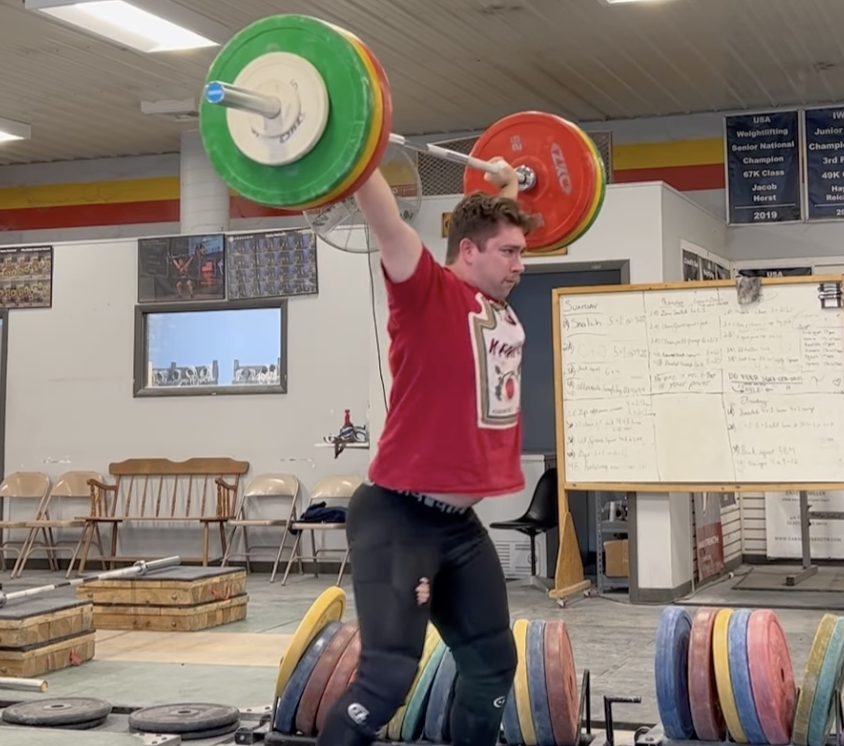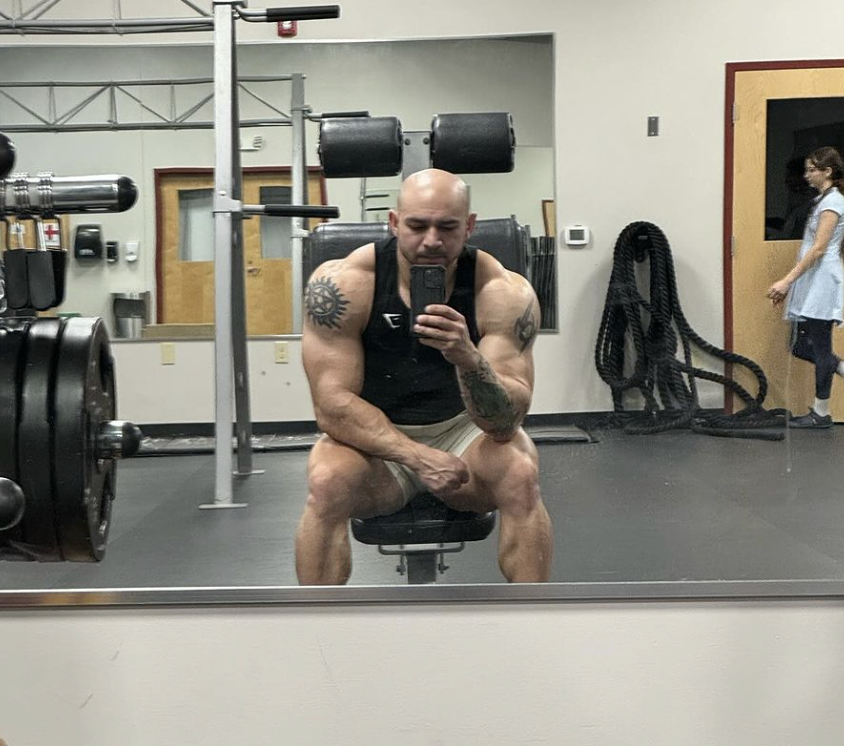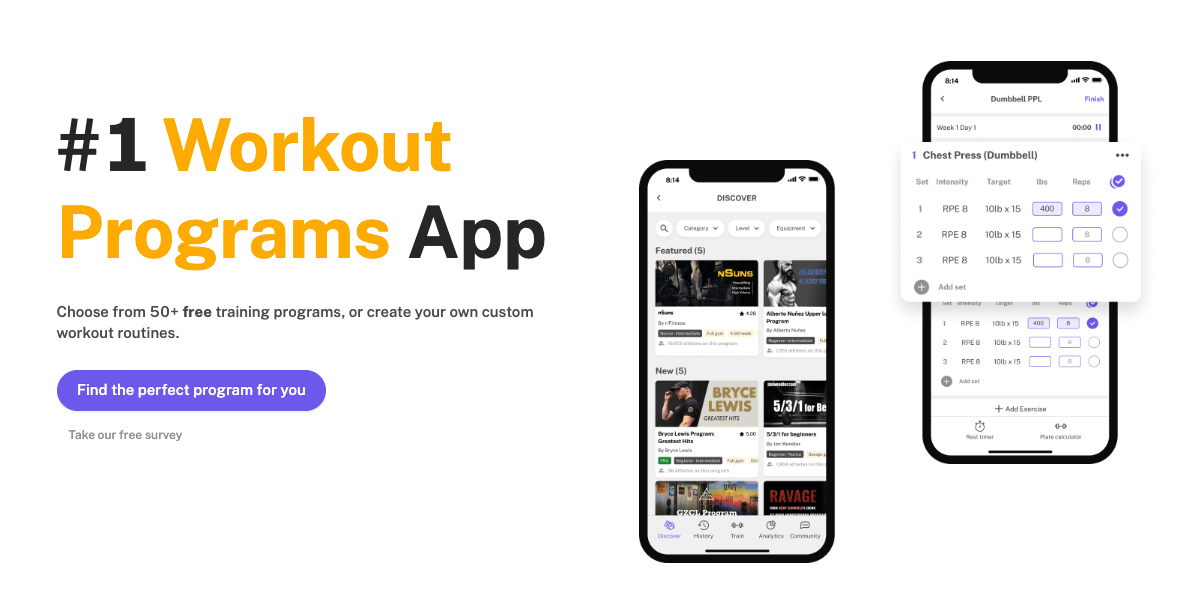A Guide to Mastering the Overhead Press
Written by The Boostcamp Editors
Blow up your delts
If you hit the gym, you’ve probably heard about the big three compound lifts which consist of the bench press, the deadlift, and the barbell squat. These exercises are often considered the cornerstone of strength training, and many different workout routines will include them, whether you are training for powerlifting or bodybuilding. However, there is one more movement that you should consider a must-do, and that is the overhead press. Also known as the shoulder press, strict press, military press, or standing press, the overhead press offers a range of benefits that can help you build upper-body strength, improve your posture, and develop bigger shoulders.
The overhead press is a compound exercise that targets multiple muscle groups in the upper body, including the shoulders, triceps, and the upper back. It is a highly effective exercise for building overall upper-body strength and stability. In addition, the overhead press has specific carryover to various strength sports, making it a valuable addition to any workout routine.
In this beginner's guide to the overhead press, our team at Boostcamp will explore the proper technique, variations, common mistakes to avoid, and safety tips. Whether you are new to strength training or a seasoned lifter, this guide will provide you with the knowledge and tools to perform the overhead press with confidence and efficiency.
Key Takeaways
The overhead press is a highly effective exercise for building upper-body strength and bigger shoulders.
It is important to have good shoulder mobility and core stability before attempting the overhead press.
The overhead press works the shoulder muscles, triceps, core muscles, and upper back.
Dumbbells and barbells can be used for the overhead press, each with its own benefits.
Proper form and technique are crucial to avoid common mistakes and prevent injury.
There are variations of the overhead press that can be incorporated into a workout routine for added variety and challenge.
Understanding the Overhead Press

The overhead press, also known as the shoulder press, or military press, is a compound exercise that primarily targets the muscles of the shoulders, triceps, and upper back. It involves pressing a weight overhead from a starting position at shoulder height, whether you are performing it standing or seated. The range of motion for the overhead press varies depending on the individual's mobility and strength.
The shoulder press is a fundamental movement pattern that mimics the action of pushing an object overhead. It is a functional exercise that can improve upper-body strength and stability, making it beneficial for everyday activities and athletic performance.
During the overhead press, the shoulders and triceps are the primary movers, while the upper back muscles and core muscles assist in stabilizing the body. The range of motion for the overhead press typically involves starting with the weight at shoulder height and pressing it overhead until the arms are fully extended. This full range of motion allows for maximum activation of the shoulder muscles and promotes strength and stability throughout the entire shoulder girdle.
Overhead pressing exercises can be performed using various pieces of gym equipment, including dumbbells, barbells, kettlebells, or resistance bands. Each type of equipment offers its own set of benefits and challenges, allowing for customization and progression based on individual goals and fitness levels.
Preparing for the Overhead Press
Before performing the overhead press, it is important to prepare yourself physically and mentally. Here are some key considerations:
Warm-up: Prior to starting your workout, it is important to warm up your muscles and joints. This can be done through dynamic stretching, mobility exercises, and light cardio.
Proper form: Familiarize yourself with the correct form and technique for the overhead press. This includes proper grip, body positioning, and range of motion.
Progression: Start with a weight that allows you to perform the exercise with proper form and then look to gradually increase the weight as you become stronger and more comfortable with the movement.
Equipment You Will Need
To perform the overhead press, you will need the following equipment:
Dumbbells: A pair of dumbbells is commonly used for the dumbbell overhead press. Choose a weight that challenges you but allows you to maintain proper form throughout the exercise.
Barbell: A barbell is used for the barbell overhead press. The weight of the barbell can be adjusted by adding weight plates. Start with a weight that you can comfortably lift and gradually increase the weight as you become stronger.
Power rack or squat rack: A power rack or squat rack is helpful for the barbell overhead press, as it provides a stable structure to safely rack and unrack the barbell.
Bench: A weight bench can be used for seated variations of the overhead press, such as the seated dumbbell press. It provides support and stability during the exercise.
When performing the overhead press, it is important to follow the proper bar path to ensure optimal muscle engagement and prevent injury. The bar should start at shoulder height and move in a straight line directly overhead. Avoid excessive leaning back or pushing the bar in front of the body.
Setting Up Your Space
Creating a safe and efficient workout environment is essential for performing the overhead press. Consider the following factors when setting up your space:
Clear area: Make sure you have enough space to perform the exercise without any obstructions or hazards. Clear the area of any objects that may interfere with your movement.
Flooring: Choose a stable and non-slip surface for your workout area. This will help prevent any accidental slips or falls during the exercise.
Mirrors: Having mirrors in your workout space can help you maintain proper form and technique during the overhead press. It allows you to visually check your alignment and make any necessary adjustments, as well as have a better mind-muscle connection.
Spotter: If you are lifting heavy weights or performing the exercise at a high intensity, or going for a one rep max, it is advisable to have a spotter present. A spotter can assist you with the lift and help ensure your safety.
By setting up a safe and well-equipped space, you can focus on performing the overhead press with proper form and technique, maximizing your results and minimizing the risk of injury.
Step-by-Step Guide to Performing the Overhead Press
Performing the overhead press with proper form and technique is crucial for optimal results and safety. Here is a step-by-step guide to performing the overhead press:
Set your feet shoulder-width apart and grip the barbell or dumbbells with a slightly wider than shoulder-width grip.
Position the weight at shoulder height, with your elbows pointing forward and your wrists stacked over your elbows.
Brace your core, keep your chest lifted, and maintain a neutral spine.
Press the weight overhead, fully extending your arms while maintaining control and stability.
Lower the weight back to the starting position in a controlled manner, maintaining proper form throughout the movement.
Dumbbell vs. Barbell Overhead Press
The overhead press can be performed using either dumbbells or a barbell, each with its own advantages and considerations. Here are some key differences between the dumbbell and barbell overhead press:
Dumbbell Overhead Press:
Involves using a pair of dumbbells held in each hand.
Allows for greater freedom of movement and a wider range of motion.
Can help improve shoulder stability and address muscle imbalances.
Requires more stabilization and coordination.
Allows for unilateral training, which can help identify and correct strength imbalances.
May be more challenging for beginners or those with limited shoulder mobility.
Requires a starting position with the dumbbells at shoulder height and palms facing forward.
Barbell Overhead Press:
Involves using a barbell held with both hands.
Provides stability and control through a fixed bar path.
Allows for heavier weights to be lifted.
Engages more overall muscle mass due to the bilateral movement.
May be easier for beginners or those with limited coordination.
Requires a starting position with the barbell at shoulder height and a grip slightly wider than shoulder-width.
Whether you choose to perform the dumbbell press or barbell press, it is important to maintain proper form and technique. Start with a weight that allows you to perform the exercise with good form and gradually increase the weight as you become stronger and more comfortable with the movement.
Extra Overhead Press Tips

To improve your overhead press technique and maximize your results, consider implementing the following strategies:
Experiment with different grip adjustments to find the most efficient and comfortable grip width for you.
Focus on breathing techniques, such as exhaling during the pressing phase and inhaling during the lowering phase, to enhance stability and core engagement.
Avoid common mistakes, such as flaring your elbows or lifting too heavy too soon, to maintain proper form and prevent injury.
Common Mistakes to Avoid With the Overhead Press
To ensure safe and effective overhead press technique, it is important to avoid common mistakes that can compromise your form and limit your results. Here are some common overhead press mistakes to avoid:
Incorrect elbow positioning: Avoid flaring your elbows out to the sides during the press. Instead, keep your elbows in front of you and pointed forward to engage the shoulder muscles effectively and maintain proper joint alignment.
Lifting too heavy too soon: Progress gradually with your weights and avoid the temptation to lift heavier than your current strength level. Lifting too heavy too soon can compromise your form and increase the risk of injury.
By focusing on proper form, technique, and progression, you can avoid these common mistakes and perform the overhead press with confidence and effectiveness.
Overhead Press Variations for Beginners
To add variety and challenge to your overhead press routine, consider incorporating these variations suitable for beginners:
Seated Dumbbell Press: Perform the overhead press while seated on a bench or chair, using dumbbells. This variation allows for better stability and control, making it beginner-friendly.
Push Press: Incorporate a slight leg drive and explosive movement to assist with lifting heavier weights. The push press allows you to use your legs to generate momentum and help press the weight overhead.
By incorporating these variations, you can target different muscle groups and challenge your body in new ways while still focusing on building strength with the overhead press.
Building a Routine to Include the Overhead Press
Incorporating the overhead press into your workout routine can help you build strength, improve muscle definition, and enhance overall performance. Here are some considerations for building a routine around the overhead press:
Incorporate accessory exercises: Include exercises that target the small muscles and stabilizers involved in the overhead press, such as lateral raises, face pulls, and rotator cuff exercises.
Plan your workout schedule: Determine the frequency and duration of your workouts, taking into consideration your other training goals and recovery needs.
By building a well-rounded routine that includes the overhead press and complementary exercises, you can maximize your results and progress towards your fitness goals.
Incorporating Accessory Exercises
In addition to the overhead press, incorporating accessory exercises into your routine can help target the small muscles and stabilizers involved in the movement. Here are some accessory exercises to consider:
Lateral raises: This exercise targets the lateral deltoids, helping to strengthen and define the shoulders.
Face pulls: Face pulls target the rear deltoids and upper back muscles, promoting good posture and shoulder stability.
Rotator cuff exercises: Exercises that target the rotator cuff muscles, such as external and internal rotations, can help improve shoulder stability and prevent injury.
By including these accessory exercises, you can strengthen the smaller muscles involved in the overhead press and improve overall shoulder strength and stability. Perform these exercises with proper form and technique, focusing on controlled movements and appropriate resistance.
Planning Your Workout Schedule
When incorporating the overhead press into your workout routine, it is important to plan your schedule in a way that allows for proper recovery and progress. Consider the following factors when planning your workout schedule:
Frequency: Determine how often you will perform the overhead press based on your training goals and recovery needs. Beginners may start with 1-2 sessions per week, gradually increasing as they become more comfortable with the exercise.
Rest periods: Allow for adequate rest periods between sets and workouts to allow your muscles to recover and avoid overtraining. Rest periods of 1-3 minutes are generally recommended, depending on the intensity and volume of your training.
Variation: Incorporate other exercises and training modalities into your routine to target different muscle groups and prevent boredom. This can include strength training, cardiovascular exercises, and flexibility or mobility work.
By planning your workout schedule effectively, you can ensure optimal progress and results while minimizing the risk of overtraining or injury.
Where to Find Workout Routines

When incorporating the overhead press, finding a good workout program to use it in is key. Keep in mind that good programs will help with your fitness journey, you would want to find a program that caters to your needs and guides you in the right direction, making sure that you are making the most gains. If you are looking to stay on track and continue with linear progression, then finding a good workout program is the key. Where do you look for a good workout program? Check out the Boostcamp App for some great programs.
Boostcamp is home to over 50 FREE workout programs that are written by renowned coaches and consist of strength, hypertrophy, or functional fitness, or both, from the push pull legs program all the way to upper lower, there are so many programs to choose from that can help fit your needs. However, with Boostcamp, you don’t have to just follow a pre-written program (although each program is written by a professional), you also can create your own program as well, and track your progress to make sure you are on the right track. That being said, when you are looking to incorporate some serious training to further your progress, then check out Boostcamp.
Conclusion
In conclusion, mastering the overhead press requires dedication and proper technique. Understanding the nuances of form, grip, and breathing is crucial for a safe and effective workout. Don't rush into lifting heavy weights; focus on building strength gradually. Incorporating variations like seated presses and push presses can add excitement to your routine. Remember, safety is paramount – warm up properly and listen to your body's cues. Consistency and patience will lead to progress in your overhead press journey. Keep learning, stay motivated, and enjoy the benefits of this empowering exercise. Happy lifting!
Also, be sure to follow Boostcamp on Instagram and subscribe on YouTube!


